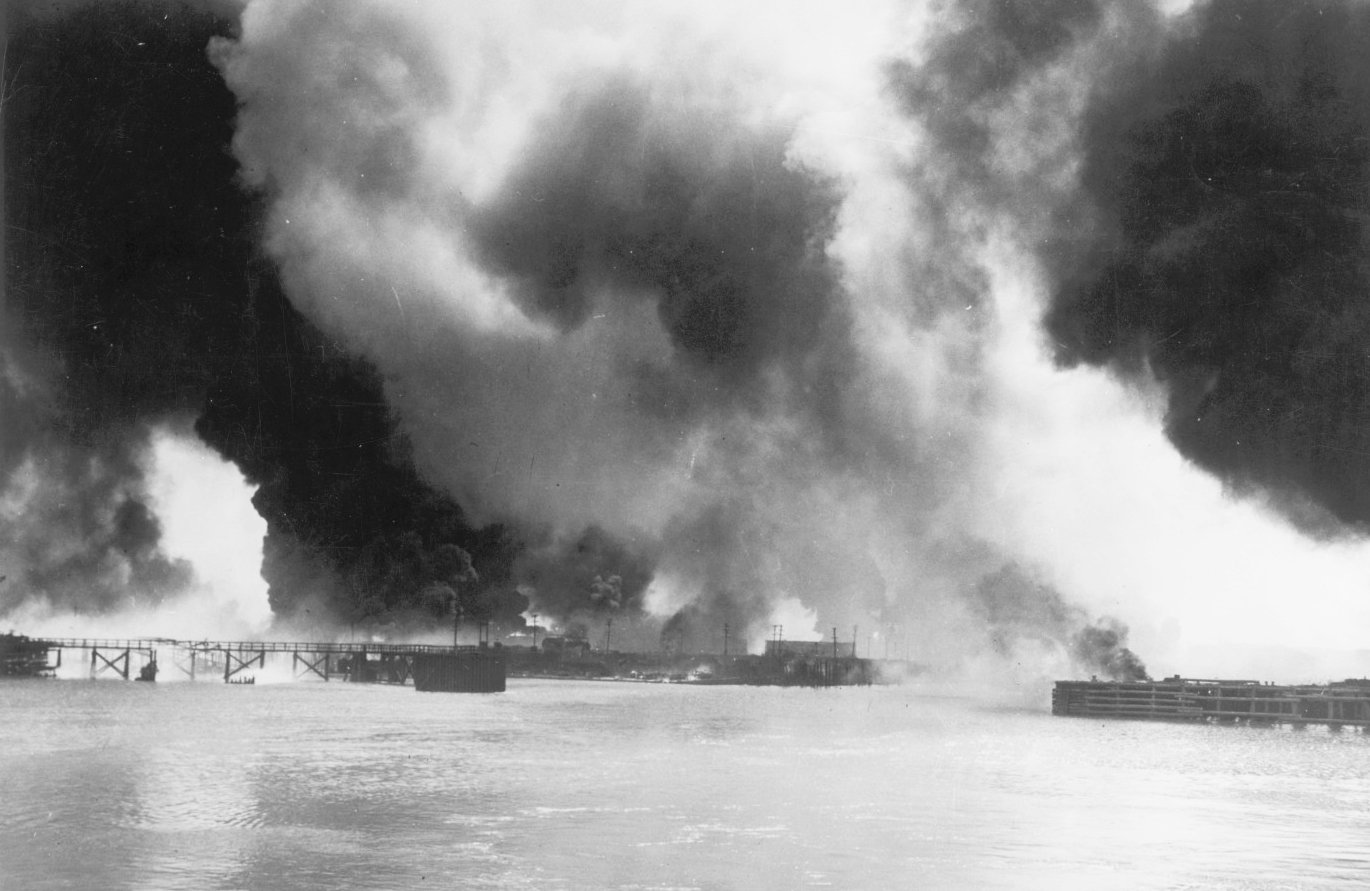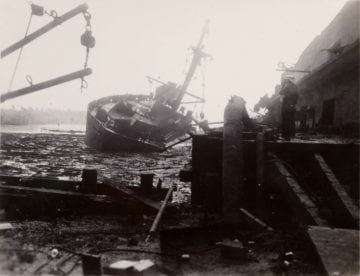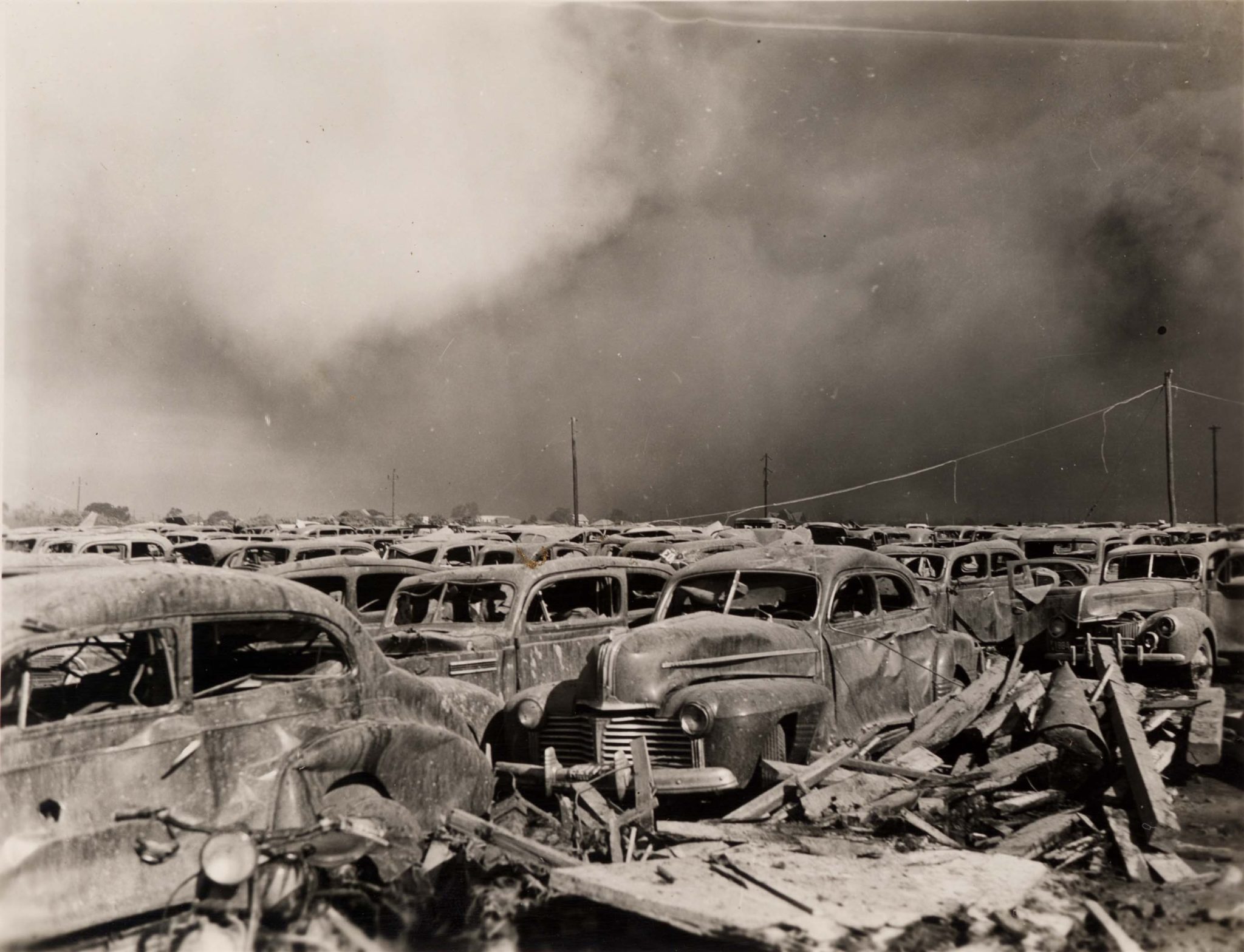
The Day the Windows Shook
Grappling with the damage wrought by the Texas City disaster, more than 70 years later.
A version of this story ran in the June 2018 issue.
Above: Burning storage tanks and raised pipelines at the port after the 1947 Texas City Disaster.
We were all gathered in the auditorium of Beaumont’s Millard Elementary School when the windows began rattling, a strong enough vibration that 71 years later I remember the moment. Though I could not tell you the names of my third-grade teacher or more than one or two of my classmates, I distinctly remember feeling a tinge of fear not unlike what I experienced when I heard the sirens signaling a practice air raid during World War II.
I remember, too, how we all turned to look out the windows and saw only the placid blue Texas sky on that unseasonably cool April morning. We would not know for some time about dishes crashing off shelves in nearby Port Arthur, or people 160 miles away in Palestine hearing a loud boom and feeling the earth shudder, or a bus on the Houston-Galveston highway that was lifted off the pavement and set back down.
We did not yet know that the French freighter S.S. Grandcamp and the 2,300 tons of ammonium nitrate fertilizer in its cargo hold had been blown a couple thousand feet in the air, or that April 16, 1947, would forever be known as the Texas City disaster — the deadliest industrial accident in American history. It would also send shockwaves through my family.
–
My cousin worked the night shift at the Monsanto Chemical Company. He was installing siding on a neighbor’s house that morning when the alarm sounded for him and the city’s 26 other volunteer firefighters to head to the dock. His wife and three sons watched as he grabbed an aluminum hard hat and drove off in his 1941 Ford, headed for the wharf, where the orange smoke was attracting a crowd.
A few days later, my parents and I drove the 100 miles to Texas City so my father could make the grim rounds at the high school gymnasium, which was serving as a morgue. My mother and I waited in the car as Daddy walked up and down the rows of unidentified bodies, each covered with an Army or a Navy blanket and with a numbered tag attached to the big toe. None of them were my cousin.

We were looking for Marion Donnis Westmoreland — Jack, to his friends in the fire department, a 32-year-old who had been orphaned at 2 when his parents and a younger brother died in the 1917 flu epidemic. He had lived for a time with relatives in the piney woods of East Texas. At age 12, he made his way to Galveston and eventually to Texas City, where he worked his way up to shift operator at Monsanto, doing carpentry on the side.
In a town dominated by refineries and chemical plants, being a volunteer firefighter was a responsibility he and the other men took seriously, which is how he found himself hurrying to the wharf that day. The Grandcamp was one of three ships docked at the pier that morning. It had arrived five days earlier to begin loading the ammonium nitrate, which the Port of Houston had refused to handle out of safety concerns. The fertilizer was on its way to Europe to replenish war-ravaged farmland. Though ammonium nitrate was a major component of World War II munitions, the fertilizer carried no warnings, and so the loading proceeded without question — a move some would later attribute to the city’s push to become a major seaport.
To live in Texas, it seems, is to live with fire.
By the time Marion Donnis and the other firefighters arrived, the fire was out of control, the intense heat turning water from their hose to vapor. Yet there remained little concern about the situation onboard the Grandcamp or the nearby High Flyer, with its own load of ammonium nitrate, and the crowd of onlookers continued to grow, oblivious to the danger they were in. Fires were fairly common on the wharf, and no one saw this one as any different.
At 9:12 a.m., flames shot from the Grandcamp’s open hatch and a deafening blast — the one that rattled the windows at my school — blew the ship to pieces, sending a cloud of dense black smoke thousands of feet into the air and scattering the ship’s remains across the city. The 2-ton anchor landed more than a mile away. Two small planes were knocked out of the sky, and a 15-foot wave carried a barge 100 feet inland, bringing it to rest on the smoldering wreckage of a fire truck, then sweeping many of the dead and injured into the turning basin as the water retreated.
Flying shrapnel killed and injured hundreds, puncturing pipes and storage tanks at the nearby refineries and chemical plants, the sparks and debris setting off still more fires and explosions across town. Sixteen hours later, the High Flyer blew up in what some described as the conflagration’s most powerful blast of all.
By the time the fires burned themselves out a week later, the entire wharf area and the city’s refineries and chemical plants were in ruins. A third of the town’s 1,510 houses were condemned, leaving 2,000 people homeless. Some estimates put the property damage at almost $100 million — more than $1 billion in today’s dollars — and even that figure was considered low, given the 1.5 million barrels of petroleum products that went up in flames.
The official Red Cross death toll was 576, including 63 unidentified bodies. Another 113 were listed as missing, their remains never recovered, Marion Donnis and the rest of the volunteer firefighters among them. The injured numbered more than 3,000.
Even while the fires were still raging, Monsanto vowed it would rebuild, which it did more quickly than one would have thought possible, and while the harbor wasn’t clear of debris until 1949, the port reopened in two weeks. Amazingly, most residents returned, willing to overlook the dangers that come with living among refineries and chemical plants.

These dangers persist. In 2005, a BP refinery in Texas City exploded, killing 15 and injuring 180. In 2013, a fertilizer plant explosion in West killed 15 and injured 160. And in April, a Valero refinery in Texas City caught fire. This time, firefighters got the blaze under control after an hour and a half and no one was hurt, but the news still felt eerie. Government oversight has weakened in recent years, with then-Attorney General Greg Abbott ruling in 2014 that companies may keep their chemical inventories secret. To live in Texas, it seems, is to live with fire.
–
Mattie Lou Westmoreland, Marion Donnis’ wife, was standing on her back porch the morning the Grandcamp blew up, the smoke suddenly shooting high above the rooftops. There were two deafening booms, and the house seemed to rise and settle around her. She waited for Marion Donnis to come home to check on her and the three boys, though deep down she knew he wouldn’t. That morning he had told her of a premonition, a feeling he couldn’t describe — sort of a homesick sensation. Years later, she said she knew from the beginning that she would never see him again.
Two of her sons, Richard and Don, were unhurt. The latter was in school when the fire broke out and somehow bicycled home amid the chaos. David, the youngest, received minor cuts from flying glass. He remembers now how scared he was that day, how he sat on the curb in front of the house, facing away from the harbor, to get as far as he could from the fire. For years, loud noises startled him, and he felt uneasy whenever there was a fire. Both he and Don remember thinking their father would return home, that one day they would open the door and he would be there.
The family all say they felt no qualms about staying in Texas City. All three sons lived and worked there at some point, and Mattie Lou enrolled in business school and went to work as a secretary to support the family. She lived in the same house, a mile from where the Grandcamp exploded, until she died six years ago at age 96.
The night after my father made the rounds at the gym, we stopped to see Mattie Lou and her three boys. The shattered windows had been repaired by then, the china cabinet righted but empty. I remember the night as strangely quiet, the conversation in lowered voices and soft words. The April evening turned cool, and Mattie Lou decided to light a gas space heater. I felt panic building inside me as she reached for a box of matches. I remember watching as she struck the match and held it to the gas and the relief I felt when the heater lit up and nothing, not anything at all, exploded.


